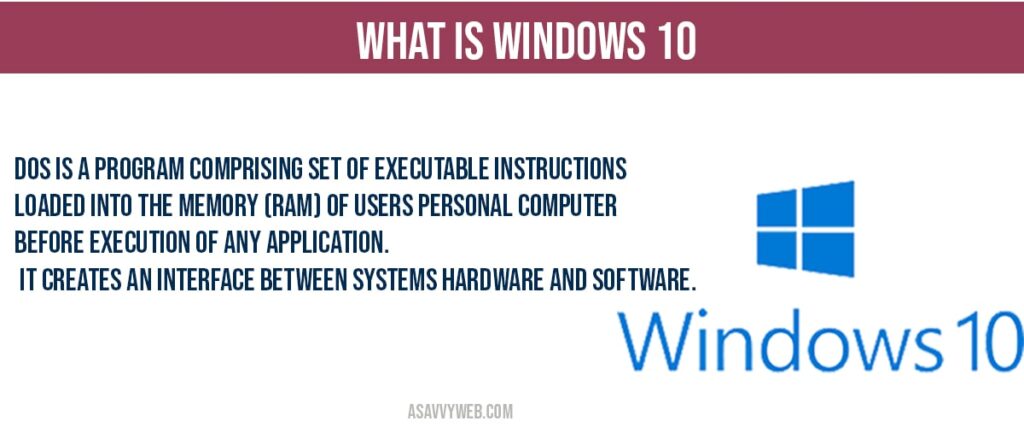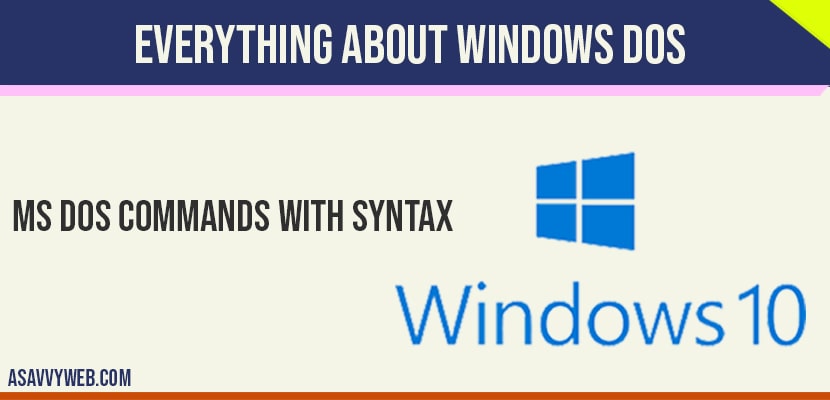DOS is a disk operating system used for operating the disks which is developed by Microsoft corporation in 1981 with name as MS-DOS version 1.0. But in practice, DOS Plays important roles than just operating disks but also by using DOS commands you can fix any issues on your computer by executing commands like SFC scans, CHKDSK, DISM and most used DOS commands.
DOS also enables the user to organize data files, load and execute program files and control the input and output devices attached to the computer.
DOS is a program comprising set of executable instructions loaded into the memory (RAM) of users personal computer before execution of any application. It creates an interface between systems hardware and software.
Dos is a single user and single tasking operating system which provides character user interface/text- based interface which means the user interacts with this operating system by using set of character and text based commands. DOS provides a prompt screen for the user (Command Prompt / DOS prompt: like: C:\users\username> or D:\>), where user can type in commands from the keyboard. The flashing underscore next to the command prompt is called the cursor. The Cursor shows where the command user type will appear. The system is entirely case insensitive, i.e, user can type the command either in upper and lower case letters. By using the commands provided by DOS we can perform tasks like file or directory management, disk management, hardware configuration, and memory management etc.

DOS Commands are Written in Which Language?
Dos commands are written in simple English language and response messages are displayed in simple English and dos commands are very easy to learn and remember DOS commands while executing.
MS DOS Commands With Syntax:
cd : Change directory or display current directory path.
cls : Clear the window.
dir : Display list of contents of current directory.
notepad : Run the Windows Notepad text editor.
type : Displays the contents of a text file.
help : Display list of commands or help about a command.
Regularly used MS-DOS commands are:
assoc : Displays or modifies filename extension associations.
attrib : Displays or changes file attributes.
call : Calls one batch program file from another.
chkdsk : Checks a disk and displays a status report.
chkntfs : Displays or modifies the checking of disk at startup.
color : Sets the text and background colors.
comp : Compares the contents of two files or sets of files.
copy : Copies one or more files to another location. See also: xcopy
date : Displays or sets the computer’s date. See also: time
del (or erase) : Deletes one or more files.
defrag : Defragment the specified storage device.
doskey : Display command history; define macros.
echo : Displays messages, or turns command echoing on/off.
edit : Runs the MS-DOS text editor. See also: notepad
exit : Closes the MS-DOS window.
fc : Compares two files or sets of files and displays the differences.
find : Searches for a text string in a file or files.
findstr : Search for a regular expression text string in a file or files.
goto : Used in a batch program file to jump to a particular line.
if : Used in a batch program file to perform conditional testing.
md (or mkdir) : Creates a directory.
more : Displays the contents of a file one screen at a time.
move : Moves one or more files from one directory to another directory.
rd (or rmdir) : Removes a directory.
rem : Used in a batch program file to identify comments.
ren (or rename) : Renames a file or files.
sort : Sorts input.
start : Starts a new window to run a specified program or command.
time : Displays or sets the computer’s time. See also: date
tree : Graphically displays the directory structure of a drive or directory.
xcopy : Copies files and directory trees. See also: copy
The following internet related commands are not part of MS-DOS but can be typed at the MS-DOS command prompt:
arp : Displays ARP (address resolution protocol) translation tables.
ftp : FTP (file transfer program) to transfer files to/from server.
ipconfig : Displays internet configuration, including IP address.
netsh : Network services shell.
nslookup : Lookup IP address to/from domain name.
netstat : Displays current TCP/IP network connections and statistics.
ping : Ping the specified internet IP address or host name.
telnet : Starts a text-based telnet session to the specified host.
tftp : Transfers files to/from remote computer running TFTP service.
tracert : Traces the route to the specified IP address or host.
The following command are not part of MS-DOS and do not come with Windows but are available from third-parties. Some are equivalent to the Linux utility by the same name.
config : Defragment one or more files (rather than entire drive).
clip : Copy command output to Windows clipboard. See: paste
du : Displays disk usage for selected files or directories.
lynx : Text based web browser.
paste : Paste Windows clipboard to command input. See: clip
strings : Find all strings of a specified minimum length.
whois : Lookup domain ownership information.

